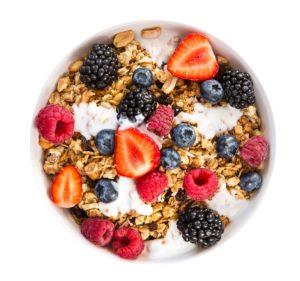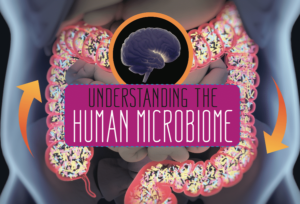Eating for Weight Control
Portion Distortion
No wonder social media feeds are packed with pictures of overflowing smoothie bowls: It appears people feel the types of foods they consume play a bigger role in their health goals than the volume they eat. As a result, a study from Vanderbilt University published in Management Science suggests that those who are trying to maintain a healthy body weight or wishing to shed a few pounds might be prone to overeating “healthy” items like nuts, granola and avocados. The upshot: The public should be educated about practicing portion control—for foods of all kinds.
Exercise and the Gut Microbiome
New research suggests that endurance exercise positively affects the gut microbiome, but only for lean individuals and only for as long as exercise continues. Researchers at the University of Illinois at Urbana-Champaign conducted the study with 32 sedentary men and women—some lean, some obese. The purpose was to explore the impact of endurance exercise on the composition, functional capacity and metabolic output of gut microbiota. Investigators collected samples from the subjects before and after 6 weeks of exercise, then after 6 weeks of no exercise.
Comprehensive Research Project on How to Create an Exercise Habit
24 Hour Fitness® is partnering with the University of Pennsylvania Behavior Change for Good Initiative [BCFG] to support research into what works best for creating lasting exercise habits. With an interdisciplinary team of world-renowned researchers, the BCFG addresses the broader question of how to make positive behavior change stick in aspects of life related to health, education and savings.
Study Launched on Molecular Changes Related to Exercise
In April, Louisiana State University researchers in Baton Rouge held a training for 120 scientists to kick off a national research consortium designed to create a comprehensive map of the body’s molecular responses during and after exercise. The purpose of the $170 million, multicenter, 6-year research project is to promote understanding of how physical activity improves health and prevents disease.
The Connection Between Inactivity and Obesity
Can we say that inactivity and obesity are directly related? Scientists are still addressing this issue. The 2018 Physical Activity Council Participation Report shows that 82.4 million people—28% of the American population—are inactive. At the same time, the Centers for Disease Control and Prevention reports that more than one-third (36.5%) of U.S. adults are obese (NCHS Data Brief, No. 219, November 2015).
Exergaming May Improve Independence Among Older Adults
Maybe you’ve thought about integrating exergaming—exercise combined with video games and other elements of technology—into some of your classes or sessions. Don’t forget to include older adults. A recent study found that seniors with mild cognitive impairment (MCI), a precursor to Alzheimer’s, showed significant improvement in certain complex thinking and memory skills after exergaming.
Equal Calories Burned ≠ Same Results
Many people fixate on the number of exercise calories they burn. New research, sponsored by Les Mills International, shows that even when two group fitness activities (indoor cycling and a resistance workout) were matched for duration and caloric expenditure, they did not have equivalent metabolic effects—which could influence long-term training results. Lead study author Nigel Harris, PhD, said, “The type of exercise used to burn those calories . . . impacts the long-term positive effects that exercise has on the body.”
Question of the Month
America has become a nation of snackers and around-the-clock eaters. But for people who want to get healthy, it might be a good idea to avoid the kitchen more often. Intermittent fasting—cycling between periods of normal consumption and periods of lower calorie intake—has become increasingly popular, and research is starting to show that the approach has promise for weight loss and other health measures.
Portions: We Can Be Happy With Less
Ballooning portion sizes are considered a major player in the startling rise in obesity rates in recent decades, but current research points to evidence that we can turn this around.
A study in the April edition of The American Journal of Clinical Nutrition showed that exposure to smaller food portions can recalibrate people’s perception of how much is enough. In the first of three experiments, volunteers randomly ate either larger (440-calorie) or smaller (220-calorie) portions of the same quiche-and-salad meal.
To Grow Healthier, Happier Adults, Raise Fit Kids
Today’s inactive kids are tomorrow’s unhealthy adults. Our society will pay the price for young people’s profound lack of exercise if we fail to turn this trend around. Few behaviors more significantly influence child health than physical activity. Yet children and adolescents are not moving enough, at the expense of their own health as well as that of their communities. More needs to be done to support families and society in raising fit kids.
Stress and Nutrition
Feeling stressed? You’re not alone! The trick is knowing what to do about it.
Research tells us that stress-relieving strategies include making a concerted effort to minimize stressors, engaging in meditation and physical activity, and nurturing strong social relationships.
That’s good advice, but it ignores the common plan that many of us resort to: the “comfort food” strategy.
Weight Loss Runs in the Family
It turns out that people who make an effort to shed a few pounds aren’t just in it for themselves; they may be helping their significant others trim down, too. Research published in the journal Obesity recounted a University of Connecticut study that monitored the weight loss progress of 130 people for 6 months Ñhalf of them on a structured Weight Watchers® program and the other half on a self-guided program combining education, healthy eating and exercise.
Research Update: The Value of Exercise for Women’s Health
Fitness pros have a unique opportunity to take a leadership role by guiding their female clients toward a healthier, movement-oriented lifestyle. This women’s health research update discusses contemporary scientific findings you can use to educate your clients and plan up-to-date programs.
Understanding the Human Microbiome
Exploration of the human microbiome is leading to revolutionary changes in health, wellness and disease management.
High-Intensity Interval Training for Fat Loss
Two recent studies reveal that high-intensity interval training has the ability to produce high-impact fitness gains in a short time frame.
Fit and Fat?
Weight loss may be the number-one goal for your clients, and if pounds don’t melt away quickly, some people may get discouraged and quit. New research strengthens the case that your program is still helping them obtain positive health outcomes, which is motivation to keep striving. In other words: Being fit benefits health even among people with severe obesity.
Behavior Change: What the Research Tells Us
Behavior change psychology has immense value to personal trainers and other fitness pros looking to motivate their clients.
Exercise Doesn’t Have To Be Strenuous To Be Effective
We know that replacing sedentary behavior with physical activity yields numerous benefits. And while high-intensity models are touted as a way to fast-track success, a new study out of Sweden says it’s not necessary to go all-out in order to boost health.
Location Is Everything When It Comes to BMI
The results are in: According to a new study, people who live within close proximity to a gym or activity center weigh less than those who don’t. Access to fast-food restaurants may also affect weight, say the study’s authors.
Selfies, Weight Loss and Virtual Support
Social media and selfie photos can play a positive role in helping people achieve weightloss goals, according to a study published in the Journal of Interactive Marketing in 2017.


















